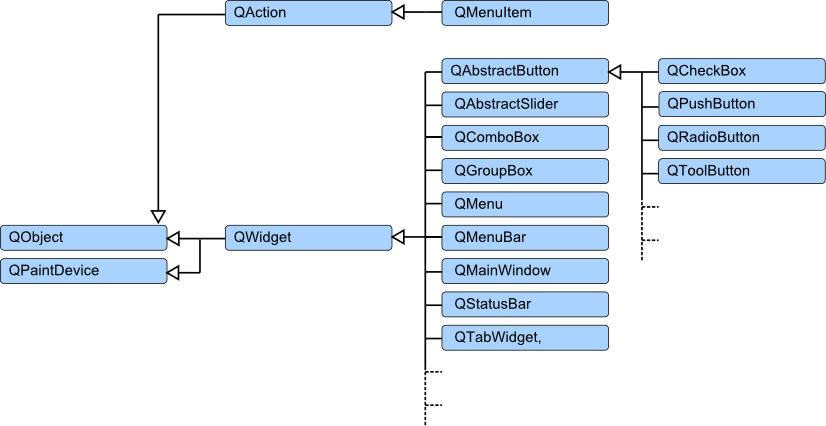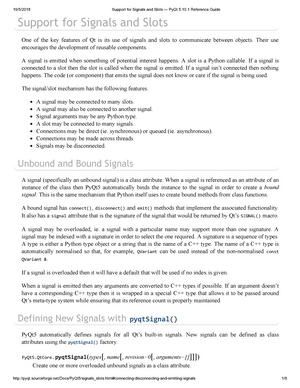Qt Signal Slot Different Class
The one thing that confuses the most people in the beginning is the Signal & Slot mechanism of Qt. But it’s actually not that difficult to understand. In general Signals & Slots are used to loosely connect classes. Illustrated by the keyword emit, Signals are used to broadcast a message to all connected Slots. If no Slots are connected, the. Slots are assigned and overloaded using the decorator QtCore.Slot. Again, to define a signature just pass the types like the QtCore.Signal class. Unlike the Signal class, to overload a function, you don't pass every variation as tuple or list. Instead, you have to define a. Signals and slots are loosely coupled: A class which emits a signal neither knows nor cares which slots receive the signal. Qt's signals and slots mechanism ensures that if you connect a signal to a slot, the slot will be called with the signal's parameters at the right time. Signals and slots can take any number of arguments of any type. The receivers of signals are called Slots in Qt terminology. A number of standard slots are provided on Qt classes to allow you to wire together different parts of your application. However, you can also use any Python function as a slot, and therefore receive the message yourself.
The following sources have been used in making this material:
If your knowledge on signals and slots is rusty or they are a completely new concept to you, you can get started with the Programming 2 material on Qt basics.
Signals and slots¶
In Qt, signals and slots are a way for objects to communicate with eachother. A signal is emitted when some event occurs in the program. For example, when a button on the UI is pushed, the button (a QPushButton widget) notifys the other widgets and objects about this by emitting a signal (emitclicked()). A slot is a function called as a response to an emitted signal. For example, a slot findClicked() is executed as a response to a button click.
All subclasses of QObject or one of its subclasses can contain signals and slots. In practice, two things are required for the signal and slot mechanism to work. All classes that contain signals or slots must:
- mention the
Q_OBJECTmacro at the top of their declaration. - be derived from
QObject
Objects emit signals when their state changes in a way that may be interesting to other objects. The objects do not need to know anything about eachother. In fact, the only thing the object does is emit the signal. It does not know, care or need to know, if anyone receives the signals emitted and vice versa, a slot does not know if any signals are connected to it. Qt's signal and slot mechanism makes sure that if the signal is connected to a slot, the slot is automatically called with the signal's parameters.
One signal can be connected to as many slots as needed. If more than one slot is connected, they are called when the signal is emitted one after another in the same order they were connected. Similarly, more than one signal can be connected to the same slot. The slot is called when any of the signals are emitted. A signal can even be connected to another signal to emit the second signal as the first is emitted.
Signals¶
Qt's widgets have predefined signals. New signals can be defined in the class's signals section of the interface.
Signals must not be implemented. The meta-object compiler moc generates them automatically. A signal can never have a return type and is always void.
Slots¶
Slots are C++ functions that can be called normally as any other function. They can also be virtual if needed. In addition, signals can be connected to them. New slots are defined in the class's slots section of the interface.
The programmer implements the slots (slots are C++ functions). Similarly to functions, slots can be either public or private.
Connecting¶
Signals and slots are connected with QObject::connect(). The preferred syntax is functor based i.e.


where sender is a pointer to the QObject object emitting the signal and receiver is a pointer to the QObject object containing the slot. The second and fourth parameters are the signal and the slot respectively. The biggest benefits with this syntax is the compile-time type checking and the possibility to use lambdas as a part of the connect.
The other way to connect a signal to a slot is to use the SIGNAL and SLOT macros. This is typically referred as the old syntax.
where the SIGNAL and SLOT macros convert their parameters to strings. Type checking is left as a run time operation. However, you can connect C++ functions to QML function with this syntax.
Meta-object System¶
The Qt's meta-object system in Qt enables among other things signals and slots. It is based on three things:
# The QObject class as the a base class for objects that can take advantage of the meta-object system.# The Q_OBJECT macro at the beginning of the class declaration is used to enable meta-object features.# The Meta-Object Compiler (moc) supplies each of the QObject subclasses with the necessary code to implement meta-object features. The moc tool reads a C++ source file. For the classes that contain the Q_OBJECTmacro, it produces another C++ source file containing the meta-object code for each class. This generated source file is then typically compiled and linked with the class's implementation.
It is possible to use QObject as a base class without the Q_OBJECT macro. This means that signals, slots and the other meta-object features will not be available. For the meta-object system, a QObject subclass without meta code is equivalent to its closest ancestor with meta-object code. Therefore, all subclasses of QObject should use the Q_OBJECT macro even if they do not use signals, slots, and other meta-object system properties.
I'm writing a simple port communication program. On the GUI side of the application I have a panel with 12 buttons that send signals to the parallel port interface. The communication with the port is done and working. What I need now is an automatic switching between buttons. The goal is to start kind of screensaver that will periodically activate the buttons and send signals to the port. In practice it would look like this: a timer is started for 2 minutes and if any event occurs it is restarted. Otherwise if timer reaches timeout() the qt signal is emitted, the switching begins and the buttons are automatically click()'ed with the interval of 5 seconds.
My questions are:
- How to enable a starting timer that will be reseted if any key/mouse event occurs?
- How to define a transition between the buttons with a sleep interval?
1 answers
Используйте QTimerдля части синхронизации.
Для «экранной заставки» -like один, создать таймер одного выстрела, подключить его к пользовательскому слоту ваших, и установить его интервал до двух минут.

В этом пользовательском слоте, начать второй таймер, без единого выстрела, соединенный со вторым слотом пользовательского
И делать все , что вы хотите с точки зрения передачи сигналов к порту в autoClick.

Для отмены либо таймера, просто вызовите их stop()метод / слот.
Qt Signal Slot Different Classic
Для реализации «хранитель экрана» поведения, создать функцию, которая:
- Вызовы ,
autoTimer->stop()чтобы отключить авто щелчков - Вызывает
activeTimerr->start(2*60*1000)перезапустить , что один
Qt Signal Slot Different Classification
И называть эту функцию всякий раз , когда это необходимо. Вы можете сделать это из уже существующих слотов для кнопок, или переописать обработчик событий , как QWidget«S mouseMoveEvent, keyPressedEventи тому подобные. (Обязательно прочитайте документацию для обработчиков, некоторые требуют специальной подготовки.)